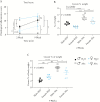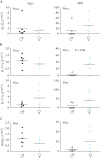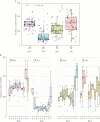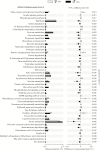Sexual Dimorphism in the Response to Broad-spectrum Antibiotics During T Cell-mediated Colitis
- PMID: 30252029
- PMCID: PMC6302957
- DOI: 10.1093/ecco-jcc/jjy144
Sexual Dimorphism in the Response to Broad-spectrum Antibiotics During T Cell-mediated Colitis
Abstract
Background: Broad-spectrum antibiotics [Abx], including combination therapy with ciprofloxacin and metronidazole, are often prescribed during the treatment of inflammatory bowel disease [IBD] to alleviate symptoms, but with varying success. In this pilot study, we studied the effects of Abx on the course of experimental colitis, with a particular focus on sex as a determinant of the microbial and inflammatory responses.
Methods: The effects of Abx were tested on colonic inflammation and microbiome in male and female Rag-/- mice, using adoptive transfer of naïve T cells to induce colitis in a short-term [2-week] and long-term [9-week] study.
Results: We observed disparities between the sexes in both the response to adoptive T cell transfer and the effects of Abx. At baseline without Abx, female mice displayed a trend toward a more severe colitis than males. In both the short- and the long-term experiments, gut microbiota of some female mice exposed to Abx showed weak, delayed, or negligible shifts. Caecum weight was significantly lower in Abx-treated females. Abx exposure favoured a quick and persistent rise in Enterococcaceae exclusively in females. Males had higher relative abundance of Lactobacillaceae following Abx exposure relative to females. Abx-treated females trended toward higher colitis scores than Abx-treated males, and towards higher levels of IL-17A, NOS2, and IL-22.
Conclusions: Although preliminary, our results suggest a differential response to both inflammation and Abx between male and female mice, The findings may be relevant to current practice and also as the basis for further studies on the differential gender effects during long-term antibiotic exposure in IBD.
Figures








Similar articles
-
Antibiotic-associated dysbiosis affects the ability of the gut microbiota to control intestinal inflammation upon fecal microbiota transplantation in experimental colitis models.Microbiome. 2021 Feb 6;9(1):39. doi: 10.1186/s40168-020-00991-x. Microbiome. 2021. PMID: 33549144 Free PMC article.
-
Diet Modifies Colonic Microbiota and CD4+ T-Cell Repertoire to Induce Flares of Colitis in Mice With Myeloid-Cell Expression of Interleukin 23.Gastroenterology. 2018 Oct;155(4):1177-1191.e16. doi: 10.1053/j.gastro.2018.06.034. Epub 2018 Jun 15. Gastroenterology. 2018. PMID: 29909020 Free PMC article.
-
Intestinal microbiota sustains inflammation and autoimmunity induced by hypomorphic RAG defects.J Exp Med. 2016 Mar 7;213(3):355-75. doi: 10.1084/jem.20151116. Epub 2016 Feb 29. J Exp Med. 2016. PMID: 26926994 Free PMC article.
-
Increased Pancreatic Protease Activity in Response to Antibiotics Impairs Gut Barrier and Triggers Colitis.Cell Mol Gastroenterol Hepatol. 2018 May 29;6(3):370-388.e3. doi: 10.1016/j.jcmgh.2018.05.008. eCollection 2018. Cell Mol Gastroenterol Hepatol. 2018. PMID: 30182050 Free PMC article.
-
Role of antibiotics for treatment of inflammatory bowel disease.World J Gastroenterol. 2016 Jan 21;22(3):1078-87. doi: 10.3748/wjg.v22.i3.1078. World J Gastroenterol. 2016. PMID: 26811648 Free PMC article. Review.
Cited by
-
Antibiotic perturbations to the gut microbiome.Nat Rev Microbiol. 2023 Dec;21(12):772-788. doi: 10.1038/s41579-023-00933-y. Epub 2023 Jul 25. Nat Rev Microbiol. 2023. PMID: 37491458 Free PMC article. Review.
-
Dynamics of Gut Microbiota Recovery after Antibiotic Exposure in Young and Old Mice (A Pilot Study).Microorganisms. 2021 Mar 20;9(3):647. doi: 10.3390/microorganisms9030647. Microorganisms. 2021. PMID: 33804656 Free PMC article.
-
The Response of the Rodent Gut Microbiome to Broad-Spectrum Antibiotics Is Different in Males and Females.Front Microbiol. 2022 Jun 9;13:897283. doi: 10.3389/fmicb.2022.897283. eCollection 2022. Front Microbiol. 2022. PMID: 35756061 Free PMC article.
-
A Pathogenic Role of Non-Parenchymal Liver Cells in Alcohol-Associated Liver Disease of Infectious and Non-Infectious Origin.Biology (Basel). 2023 Feb 6;12(2):255. doi: 10.3390/biology12020255. Biology (Basel). 2023. PMID: 36829532 Free PMC article. Review.
-
Urinary Metabolites of Green Tea as Potential Markers of Colonization Resistance to Pathogenic Gut Bacteria in Mice.Pathog Immun. 2019 Nov 14;4(2):271-293. doi: 10.20411/pai.v4i2.335. eCollection 2019. Pathog Immun. 2019. PMID: 31773068 Free PMC article.
References
-
- de Souza HSP, Fiocchi C, Iliopoulos D. The IBD interactome: an integrated view of aetiology, pathogenesis and therapy. Nat Rev Gastroenterol Hepatol 2017;14:739–49. - PubMed
-
- Liu JZ, van Sommeren S, Huang H, et al. ; International Multiple Sclerosis Genetics Consortium; International IBD Genetics Consortium Association analyses identify 38 susceptibility loci for inflammatory bowel disease and highlight shared genetic risk across populations. Nat Genet 2015;47:979–86. - PMC - PubMed
-
- Halfvarson J. Genetics in twins with Crohn’s disease: less pronounced than previously believed?Inflamm Bowel Dis 2011;17:6–12. - PubMed
-
- Manichanh C, Borruel N, Casellas F, Guarner F. The gut microbiota in IBD. Nat Rev Gastroenterol Hepatol 2012;9:599–608. - PubMed
MeSH terms
Substances
Grants and funding
LinkOut - more resources
Full Text Sources
Other Literature Sources
Medical

